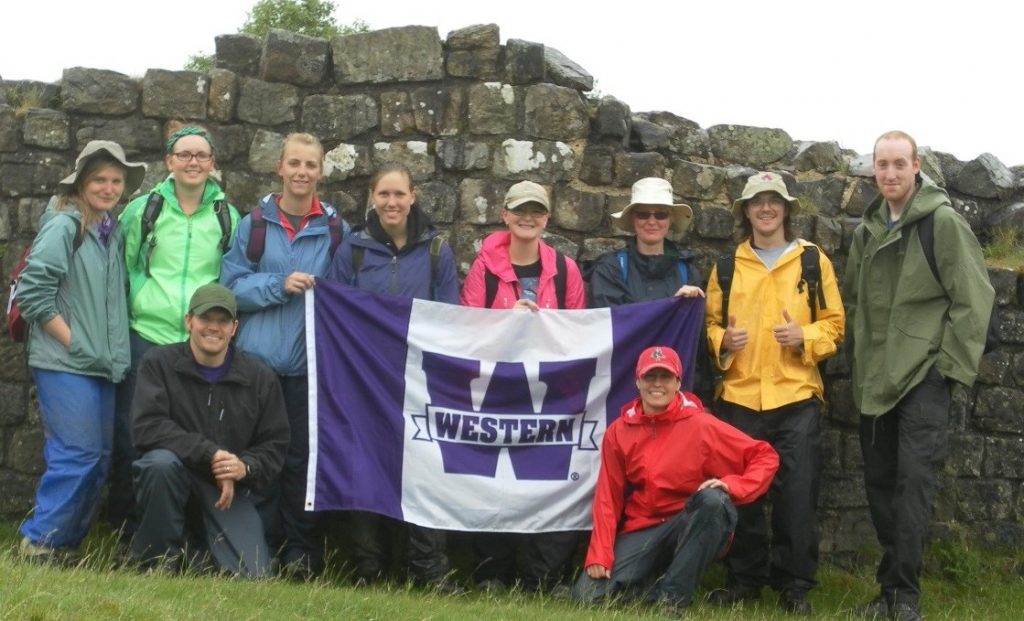Alumni Spotlight: Beth Greene, PhD ’11
 Beth Greene
Beth Greene
PhD ’11
After the whirlwind of finishing my dissertation, moving to Canada and starting a tenure-track job, things haven’t slowed down a bit! I’ve been living in London, Ontario now for almost three years and loving every minute of it. I’m an Assistant Professor at the University of Western Ontario teaching Roman Archaeology courses to both undergrads and graduate students. If you can believe it, I’m still teaching a form of the classic UNC archaeology course “Ancient Cities”! It’s a big hit at Western as well and continues to fill several hundred seats every year.
What I had most looked forward to after finishing graduate school was having the chance to share with students the wonders of Hadrian’s Wall and its spectacular archaeological landscape. Riding the coat tails of the ‘Internationalization’ push at Canadian universities, I have developed a 6-week study abroad course for students to take part in excavation at Vindolanda and to explore the sites of Hadrian’s Wall and northern England. The program was developed with and is co-directed by my colleague, Alex Meyer, also an assistant professor at Western Ontario (Ancient History and Latin). We bring eight students each year in May-June and run them ragged hiking in the rain, seeing every Roman ruin for miles around and excavating at Vindolanda. Below is a picture of us with our first group on the highest standing section of Hadrian’s Wall at Walltown Crags (that’s me in the front with the Red Sox cap on, naturally).

The course focuses on the intersection of archaeological and historical methodologies and aims to allow students to experience various approaches to the Classical World with the hope that they discover what interests them most. To that end, students learn everything about what happens on this Unesco World Heritage site from de-turfing to soil sampling to archaeological illustration. They also take part in that ever-more-necessary ‘outreach’ component by engaging the public with the history of the site through daily interaction with tourists in the museum and on site. Several of our students have returned to Canada to find jobs in Cultural Resource Management (state operated archaeological units) and within the heritage sector (museums, historical sites, etc.). So far, it has been a very successful program
My own research continues to focus on the Roman army and the role of women and families in the lives of soldiers and in military communities. I’ve published a few articles recently on various aspects of this subject and am currently co-editing a volume for Cambridge on “Women and the Roman Army.” My research at Vindolanda also continues. Currently I have the enormous task of writing up over 6000 small finds in the assemblage of archaeological leather. This is a fascinating assemblage of material, consisting predominantly of Roman shoes, which allows me to explore so many questions about the population on this site from demographic issues, to aspects of health and disability, to industry and fashion. This work also gives me the opportunity to collaborate with bioarchaeologists, zooarchaeologists and others from the anthropological world, giving the work diversified impact. When stretched to its limits the leather gives us a great deal of information about this far-flung provincial region. In short, old Roman shoes are a ton of fun!
I’m still in touch with the enormous UNC community, now spread all over the globe. As I write, I am preparing to leave tomorrow for Reading England for the Roman Archaeology Conference where I will hang out with Elizabeth Robinson (PhD 2012) and Hilary Becker (PhD 2007). Part of my summer is spent in Rome on the site at Sant’Omobono with Nic Terrenato, Andrea Brock (BA 2009; PhD candidate, Michigan) and Hilary Becker, and this spring I will ‘meet up’ with Ted Gellar-Goad (PhD 2012) and his students for an online seminar on women and the Roman army. Meanwhile, I have a Tar Heel right in my own backyard—Catherine Pratt (BA 2008; PhD, UCLA, 2014) currently teaches at Western Ontario while finishing her dissertation research and we’re practically neighbors. Keep up the good work UNC alum!
Oh, and I have an adorable little dog, a Brittany Spaniel called Aggie (short for Agrippina the Elder!).